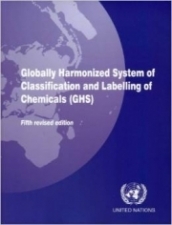The Globally Harmonized System of Classification and Labeling of Chemicals (GHS), was created by the United Nations and has united countries all over the world by uniformly implementing a consistent standard to communicate hazardous chemicals in the workplace. Prior to the existence of GHS, different countries had different standards in chemical classification and labeling. Too often, this created large gaps in safe chemical use when importing and exporting to other countries.
Although the implementation of GHS has greatly shortened the gap for safe chemical use from country to country, it is important to note that differences still exist. This article will discuss aspects of European Union Classification Labeling and Packaging (EU CLP).
EU CLP replaces two previous pieces of legislation, the Dangerous Substances Directive and the Dangerous Preparation Directive, and is aligned to GHS in the same way that OSHA’s HazCom is.  Before chemicals can be placed on the market, the industry is required to index the potential risk to human health and environment. Once chemical hazards are established, they must be communicated through GHS’s standard hazard statements and pictograms on labels and safety data sheets (SDS). For more information on SDSs, pictograms and labels check out our GHS Compliance Poster.
Before chemicals can be placed on the market, the industry is required to index the potential risk to human health and environment. Once chemical hazards are established, they must be communicated through GHS’s standard hazard statements and pictograms on labels and safety data sheets (SDS). For more information on SDSs, pictograms and labels check out our GHS Compliance Poster.
To comply with EU CLP, chemical suppliers must classify, label, and package substances and mixtures in accordance to CLP Regulation. Chemical suppliers such as manufactures, importers, producers, downstream users, and distributors must notify the European Chemicals Agency (ECHA) within one month of placing a new hazardous chemical on the market for the first time.
For the most part, suppliers can make a decision on the classification of a substance in a process called “self-classification”. In cases of the most hazardous substances (carcinogenic, mutagenic, toxic for reproduction, or respiratory sensitizer), classification of a chemical must be taken at the Community Level to ensure adequate risk management throughout the European Community.
Although GHS has unified many countries under its standard, understanding the subtle differences of other countries is critical to the overall success of GHS. Understanding and communicating the legislation of other countries allows for transparent interactions between countries and will ultimately result in a safer world for us to work and live. Contact us today if your have any concerns on regulatory compliance and GHS.







